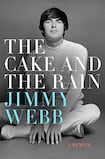
There is a fairy-tale quality to Jimmy Webb’s autobiography, hardly surprising when you consider his remarkable life. He was born and raised by a preacher in Oklahoma and achieved incredible success as a composer in LA, writing some of the most enduring and moving songs of the late 1960s.
Two aspects linger: prodigy and maturity. For some, Webb was a fantasy figure whose ability to compose instant standards – from Up, Up And Away to Didn't We – seemed mind-boggling. He recalls reading a description of himself as a "wunderkind" and had to consult a dictionary to discover the word's meaning. His melodies were wondrous, surpassed only by a precocious lyrical maturity. Despite his inexperience and modest upbringing, his songs suggested the wisdom of a man twice or three times his age. His observational skills, sense of place and wistful yearning were enshrined in that remarkable trilogy for Glen Campbell: By the Time I Get to Phoenix, Wichita Lineman and Galveston. Many more would follow.
The Cake and the Rain is fascinating, as it alternates between Webb's Midwest childhood and rise to Hollywood fame. He evokes a past of religious observance, accompanied by bullying, transcendent joys and small terrors. By contrast, LA offers hedonistic highs, fast cars and a house on the hill with "six acres of pools, gardens and waterfalls . . . century-old white oak trees". Inside his home are grand pianos, a recording studio, an ornate temple to rock icons and a floor-to-ceiling pipe organ even larger than the one seen in the film 20,000 Leagues Under the Sea.
For all this opulence, Webb craves credibility, which he rightly argues was often denied him by snobbish, hipper-than-thou rock critics offended by his Las Vegas shows and middle-of-the-road image. In truth, Webb was a countercultural proselytiser himself. Witness his outlandish "nude concerto", experimental songs such as The Yard Went On Forever or his series of self-penned albums, all of which failed to sell but deserve critical respect. His anti-war sentiments and drug excesses also placed him firmly in the hippie camp. By the 1970s, he became a cocain addict and even had his own recipe: baking soda mixed with coke, washed down with Champagne.
Irish grudges
Webb’s life is dominated by music and muses. There are many heroines in the story, notably Susan Horton, a goddess-like cheerleader who inspired several of his greatest compositions. There are also great friendships, not least the mercurial Richard Harris, who deserves several chapters of his own. He disappears from the narrative rather abruptly. Webb extrapolates mysteriously: “The Irish can silently bury a grudge deeper and hold it longer than any other creatures under Heaven.”
The author's prose is vivid and at times so florid that it resembles some of his more abstruse lyrics. He appears to be channelling MacArthur Park when he writes: "I remember her plain country short-sleeved dress and the pattern of tiny faded flowers run amok." Other rhetorical flourishes: "I supposed life, if it continued , would be an endless series of ghostly tabernacles, rising like abandoned dreams from the white chalk of the West Texas back roads." Elsewhere, he is more colloquial: a limousine is inelegantly referred to as a "black bastard" for no apparent reason.
Great raconteur
Webb is a great raconteur whose reminiscences appear honest and self-deprecating rather than sentimental or boastful. A recurring figure in the text is the devil, who accompanies Webb in several strange episodes. It’s not entirely clear whether he’s a person or an abstraction, but he’s real enough to Webb. The author’s tales of Nilsson, Lennon, McCartney and Harrison are all new to me and most welcome.
Even they pale alongside his own quixotic adventures: a sailing trip featuring UFOs and aliens; a crazy, dope-smuggling escapade to Brazil during which one of the party disappears in scary circumstances; a hubristic visit to Galveston, where he barely gets out of town alive; an air crash in which he nearly kills photographer Henry Diltz; and so on. The book closes with a harrowing account of Webb overdosing on PCP and briefly losing the ability to play the piano as the entire world is turned into rubber. It reads like an episode of The Twilight Zone.
The conflict between art and commerce, a motif that runs throughout the text, is oddly re-enacted in the book's production. Originally, Webb presented his American publishers with what sounds like a MacArthur Park-style epic, but evidently met editorial resistance: ". . . the thought of losing half of my stories became too subjective and emotional". The decision to spread the material over two or more volumes suggests economic rather than aesthetic reasoning. That said, they do justice to the integrated photos by using expensive glossy paper.
Several names are misspelled: Moke Stoller (Mike Stoller), Judy Sill (Judee Sill) and Harvey Linnman (Harvey Lippman). Ludicrously, there is no index. Considering the fantastic stories and celebrated figures Webb interacts with – Frank Sinatra, Elvis Presley, the Beatles, Joni Mitchell, Janis Joplin, David Crosby, Jackson Browne, Richard Harris, David Hemmings, Sammy Davis jnr et al – this omission is both careless and immensely frustrating. Webb’s evocative autobiography deserves better stewardship and one hopes such infelicities are rectified in the next volume.











